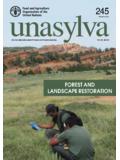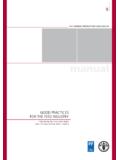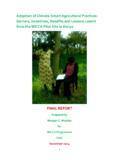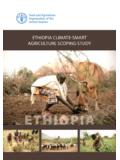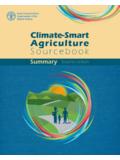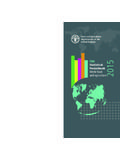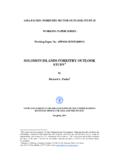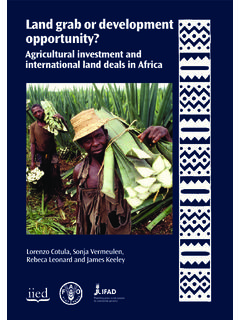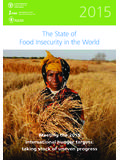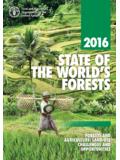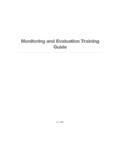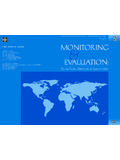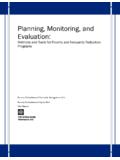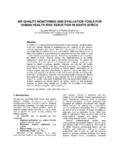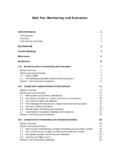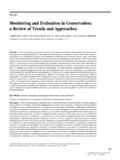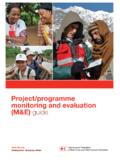Transcription of Monitoring and Evaluation Toolkit for Junior …
1 Monitoring and Evaluation Toolkit for Junior Farmer Field and Life Schools The designations employed and the presentation of material in this information product do not imply the expression of any opinion whatsoever on the part of the Food and Agriculture Organization of the United Nations concerning the legal or development status of any country, territory, city or area or of its authorities, or concerning the delimitation of its frontiers or boundaries. The mention of speci c companies or products of manufacturers, whether or not these have been patented, does not imply that these have been endorsed or recommended by the Food and Agriculture Organization of the United Nations in preference to others of a similar nature that are not mentioned. ISBN 978-92-5-105724-7. All rights reserved. Reproduction and dissemination of material in this information product for educational or other non-commercial purposes are authorized without any prior written permission from the copyright holders provided the source is fullyacknowledged.
2 Reproduction of material in this information product for resale or other commercial purposes is prohibited without written permission of the copyright holders. Applications for such permission should be addressed to: Chief Electronic Publishing Policy and Support Branch Communication Division FAO. Viale delle Terme di Caracalla, 00153 Rome, Italy or by e-mail to: Photos: FAO/ , F. Dalla Valle, FAO Jerusalem Graphic design: Antonella Por do FAO 2010. Monitoring and Evaluation Toolkit Ms Terri Ballard, Ms Tanith , Ms Francesca Dalla Valle Monitoring and Evaluation Toolkit 5. ACKNOWLEDGMENTS. Under the supervision of Carol Djeddah (Gender, Equity and Rural Employment Division, ESW), this Module has been developed by Terri Ballard from FAO's Nutrition and Consumer Protection Division (AGNA), Tanith K. Bello from FAO Kenya and Francesca Dalla Valle from FAO's ESW. Jaap Van de Pol provided the rst version of the tools. Comments, suggestions for improve- ment were provided by: Michele Tarsilla and Faria Zaman, Felicidade Panguene and Alves Nhaurire from FAO Mozambique, Winfred Nalyongo and Bernard Mwesigwa from FAO Uganda, Bonventure Achonga from the Ministry of Agriculture in Kenya, Karine Garnier from FAO Regional Emergency Of ce in Kenya and Daniel Baha from the Coast Development Authority (CDA) in Kenya.
3 Appreciation is shown to Peter Wobst and Gabriel Rugalema from FAO's Gender, Equity and Rural Employment Division (ESW). Special thanks are given to UNAIDS and the UN System-wide Work Programme on Scaling-up HIV services for Populations of Humanitarian for their key role in supporting the JFFLS and the de- velopment of the M&E manual. Monitoring and Evaluation Toolkit 7. Contents 1. introduction 9. Workshop on JFFLS M&E 9. Development of a core JFFLS Monitoring and Evaluation Toolkit 10. 2. GETTING STARTED ON M&E KEY DEFINITIONS AND CONCEPTS 11. Monitoring 11. Evaluation 11. Monitoring and Evaluation plans 12. Logical framework 12. 3. Monitoring - PROCESS Evaluation 14. Monitoring indicators 14. 4. Evaluation OF OUTCOMES AND IMPACT 15. What should JFFLS programmes be evaluating? 15. Who should carry out the Evaluation ? 15. Use of indicators to evaluate outcome and impact 16. Setting targets for results 18. Useful information for establishing targets 19.
4 Attribution 19. Importance of the baseline 20. Quantitative outcome and impact Evaluation methods 21. Qualitative outcome and impact Evaluation methods 23. Proposing a mix of methods 25. 5. RECOMMENDED CORE M&E Toolkit FOR JFFLS 27. Core on-going Monitoring tools 30. Core Evaluation tools 31. 6. DOCUMENTING AND REPORTING M&E RESULTS 34. 7. RESOURCES 35. Annex I - Monitoring TOOLS 37. Annex II - CORE YOUTH QUESTIONNAIRE 44. Annex III - EXAMPLE OF QUANTITATIVE INDICATOR CREATION 49. Annex IV - QUALITATIVE Evaluation TOOLS 53. Monitoring and Evaluation Toolkit 9. 1. introduction . The JFFLS programme was piloted in Mozambique and Kenya in 2004 and JFFLS schools have been implemented since then in Burundi, Cameroon, DRC, Gaza & West Bank, Ghana, Malawi, Namibia, Nepal, Rwanda, Sudan, Swaziland, Tanzania, Uganda, Zambia and Zimbabwe. Programme evaluations have been undertaken in ve countries up to now: Mozambique, Kenya, Uganda, Sudan and Gaza & West Bank.
5 Monitoring and Evaluation (M&E) is an important aspect to undertake in a project or programme and supports the management work to ensure compliance of its strategies, objectives and approach. It is the mechanism for which the process aspects of a programme can be tracked and accounted for, as well as its impact assessed. M&E improves programme management and implementation and builds a case for advocacy. Workshop on JFFLS M&E. FAO staff working in JFFLS programmes in ve countries (Kenya, Uganda, West Bank & Gaza Strip, Sudan and Mozambique) attended an M&E workshop on August 11-12, 2009 in Nairobi to reach consensus on core M&E tools, based on the piloting that was taken place in the ve countries, and to nalize the JFFLS M&E Toolkit . The speci c objectives of the workshop were to: 1 Understand experiences from the eld with M&E and use of existing JFFLS M . 2 De ne realistic expectations of the JFFLS (its desired impact and outcomes based on realistic appraisal of the project).
6 3 Identify a few simple core indicators of outcome and impact;. 4 Critically review all existing M&E tools for JFFLS and modify as indicated;. 5 Decide on (revised) tools to include in the nal JFFLS M&E Toolkit . Workshop participants acknowledged that programme managers as well as donors are aware of the dif culty in measuring the overall GOAL or desired IMPACT of JFFLS programmes. JFFLS are intended to improve livelihood possibilities for participants in the future in order to improve food security and (in certain areas) reduce the impact of HIV and AIDS on households. Given the short term nature of many of the JFFLS programmes, and the wide age range of participants, from 12 to 18. in most cases, a more realistic approach would be to measure changes in medium term outcomes as an indication of programme effectiveness and success. During the workshop, the group de ned the core focus areas of JFFLS in general, generated a list of the main outcomes expected under each focus area, including examples of activities that lead the JFFLS towards accomplishing the outcomes, and arrived at a list of core indicators to be measured at beginning and end to evaluate whether the outcomes were reached.
7 It was acknowledged that further work needs to be done to re ne and nalize de nition of the indicators and to ensure that the Evaluation tools are appropriate to capture the necessary information. However, the group was satis ed that the outputs of the workshop re ected consensus and provided a strong experiential basis for de ning indicators that can be utilized across a broad range of JFFLS contexts. 10. Development of a core JFFLS Monitoring and Evaluation Toolkit As a result of Nairobi 2009 M&E workshop, this core JFFLS Monitoring and Evaluation Toolkit has been written to be included in the forthcoming JFFLS Facilitator Guide. Since the Getting Started! Manual was written, speci c M&E tools have been revised and tested using a mix of methods, and a realistic appraisal has been made about to what extent impact of this type of programme can be assessed. This Toolkit is not intended to be a de nitive manual on how to set up a programme Monitoring and Evaluation system.
8 It will provide a summary of M&E principles relevant to JFFLS and describe a minimum set of core tools for on-going Monitoring and programme Evaluation . A con- siderable amount of this document will be dedicated to Evaluation of outcomes and impact, as this is the area that can cause most concern among programme managers and M&E of cers. There are a number of issues to consider when deciding how to evaluate a programme, some of which will be touched on here. During the Nairobi workshop, a core set of programme outcomes and associated Evaluation indicators were identi ed which will be presented in this Toolkit . We will suggest targets for change for the core indicators, ways to collect the information, and examples of how indicators can be created from survey data. Additionally, interview guides for focus group discussions and key informant interviews have been re ned, based on the experience of several countries. These tech- niques are useful in the nal phase of the JFFLS course to hear directly from the JFFLS participants, their caretakers and principal local stakeholders how and why the programme worked or not, what were some of the dif culties they encountered and the successes they experienced, what were any unintended outcomes, and what would be their suggestions for the next phase of the programme The concept of providing a core set of M&E tools for JFFLS is important in order to gener- ate standard information on performance across different programmes.
9 Monitoring and Evaluation systems should not represent an undue burden on Programme staff but at the same time should provide key information for Monitoring the progress of the programme and evaluating whether the programme was successful. It is assumed that programmes will have information needs beyond what the core tools provide, and thus will feel free to collect other M&E data as de ned for their speci c programmes. Monitoring and Evaluation Toolkit 11. 2. GETTING STARTED ON M&E KEY DEFINITIONS AND. CONCEPTS1. Monitoring and Evaluation is a process that helps programme implementers make informed deci- sions regarding programme operations, service delivery and programme effectiveness, using objec- tive evidence. It is a process in that it involves on-going and routine collection of information used to assess if the programme has made ef cient use of resources and is on track ( Monitoring ), and to assess to what extent the programme has reached its objectives in terms of outputs (programme activities) and outcomes and impact (whether the expected bene ts to the target population were reached).
10 Monitoring and Evaluation is often required by sponsors and other stakeholders in order to provide evidence that the investments into the project were worthwhile or whether alternative approaches should be considered to improve effectiveness. Monitoring Monitoring is the routine tracking of the key elements of programme/project performance, usually inputs and outputs, through record-keeping, regular reporting and surveillance systems. It is used to track changes in programme performance over time and is an ongoing, continuous process. It requires the collection of data at multiple points throughout the programme cycle, including at the beginning to provide a baseline; and can be used to determine if activities need adjustment during the intervention to improve desired outcomes. Monitoring is sometimes referred to as process Evaluation because it focuses on the implementa- tion process and asks key questions: How well has the programme been implemented?
